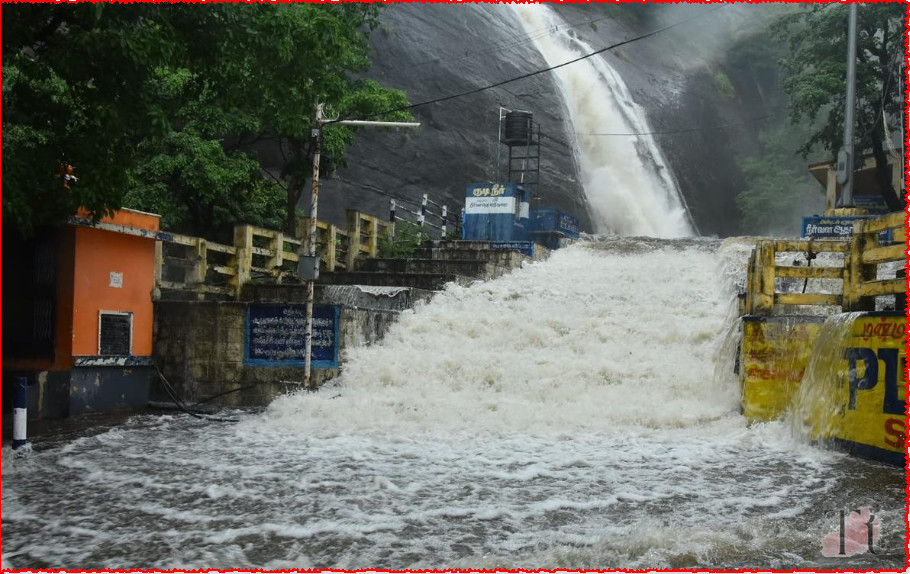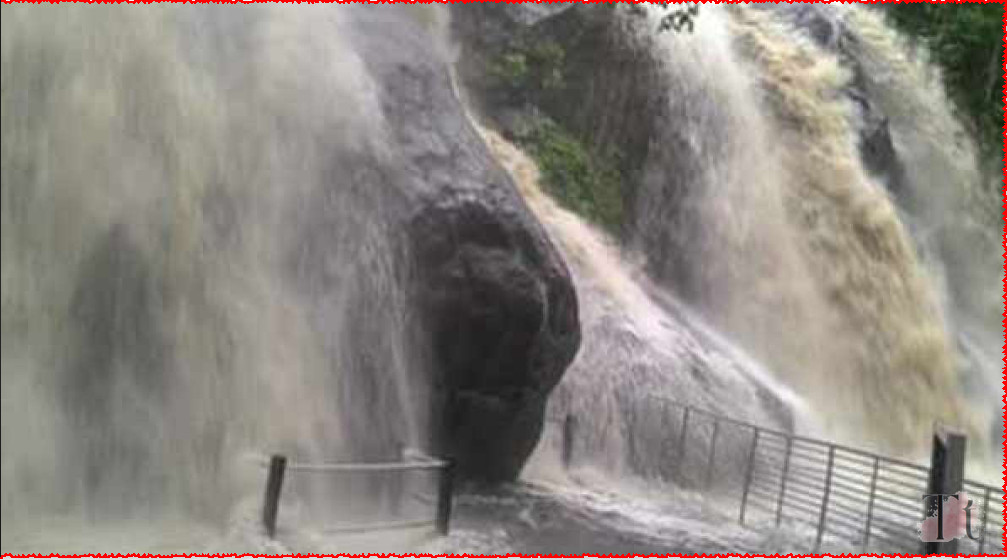On Friday, May 17, 2024, a tragic and horrifying incident occurred at the Coutrallam Falls in Tamil Nadu’s Tenkasi district, where a 17-year-old boy named Ashwin was swept away by flash floods. The sudden and intense rains, which triggered these flash floods, caused panic among the tourists present at the falls. A video that has gone viral on social media shows the terrifying moment when the flash floods struck, capturing tourists, including women and children, desperately running to escape the rushing waters.
Table of Contents

Flash Floods at Coutrallam Falls: A Deadly Natural Event
The incident at Coutrallam Falls vividly highlights the sheer power and unpredictability of nature, especially in regions prone to sudden weather changes. The video portrays the chaos and fear that ensued as the floodwaters surged unexpectedly towards the tourists. People can be seen fleeing in all directions, trying to reach higher ground or any safe area to avoid being caught in the deluge.
Ashwin, identified as a resident of Tirunelveli, was among those enjoying a visit to the Coutrallam Falls with his relatives when the flash floods hit. Despite the immediate rescue efforts by local authorities and volunteers, Ashwin was reported missing amid the chaos. A rescue operation was launched promptly to find him, but the turbulent conditions made the search extremely challenging.
The Cause: Sudden and Intense Rains
The flash floods were a result of heavy rains in the Western Ghats, which have been experiencing significant rainfall due to a weather system over the Gulf of Mannar and Kanniyakumari. This system has brought heavy rains not only to Tenkasi but also to surrounding areas, causing an increase in water levels in rivers and waterfalls. The intensity and volume of the rainfall have been severe enough to warrant safety warnings and bans on certain activities, such as bathing in the waterfalls.
The weather system over the Gulf of Mannar and Kanniyakumari has been particularly active, bringing in moisture-laden winds that precipitated over the Western Ghats, leading to sudden and heavy rainfall. The geography of the region, with its steep slopes and narrow valleys, can exacerbate the effects of such heavy rains, leading to rapid water accumulation and flash floods. These conditions are often unpredictable and can transform a serene environment into a dangerous and life-threatening situation within minutes.
Response to the Tragedy
In response to the flooding and the tragic incident at Coutrallam Falls, authorities have taken stringent measures to ensure public safety. The Tenkasi district administration has issued warnings and restricted access to the waterfalls to prevent further mishaps. Bathing in the falls has been banned, and tourists have been advised to avoid visiting the area until the weather stabilizes and it is deemed safe.
Furthermore, the India Meteorological Department (IMD) has issued forecasts of heavy rain for the upcoming days, specifically warning about potential rainfall in Tenkasi, Theni, and Dindigul districts. These forecasts have led to heightened alertness among the local administrations, which are preparing for further adverse weather conditions.

Warnings and Precautionary Measures in Nilgiris
Simultaneously, in the Nilgiris district, which includes popular tourist destinations like Ooty, the district administration has also issued warnings in light of the weather forecasts. The IMD has predicted very heavy rains from May 18 to May 20, prompting an “orange alert” for the region. District Collector M. Aruna has advised people to avoid traveling to the Nilgiris during this period due to the expected heavy rainfall, which could range between 6 cm to 20 cm.
The district administration has undertaken several precautionary measures to handle the anticipated heavy rains. Nearly 3,500 disaster response personnel are on standby, equipped with necessary tools and machinery such as earthmovers to manage potential emergencies. Additionally, around 450 temporary shelters have been prepared to accommodate people in case of evacuations. Authorities have urged residents and visitors to stay indoors and to be well-prepared if they must venture out.
The Search and Rescue Operation
The search and rescue operation for Ashwin was a tense and urgent endeavor. Local authorities, including the Collector A.K. Kamal Kishore and Superintendent of Police T.P. Suresh Kumar, arrived at the scene promptly, along with Fire and Rescue Services personnel. The rescuers scoured the area with hopes of finding Ashwin alive, despite the challenging and dangerous conditions created by the flash floods.
Tragically, their efforts concluded when Ashwin’s body was found about 500 meters downstream from the waterfall, trapped between rocks. The recovery of his body took place at around 5:10 p.m., marking a somber end to the search and highlighting the perilous nature of the sudden flash floods. This tragic outcome underscored the dangers that flash floods pose and the difficulty of conducting rescue operations in such volatile conditions.
Impact on the Community and Safety Measures
The incident at Coutrallam Falls and the subsequent preventive actions taken by the authorities highlight the critical importance of weather awareness and disaster preparedness in regions susceptible to sudden climatic changes. The flash floods serve as a stark reminder of the potential dangers posed by natural attractions, particularly during periods of unpredictable weather. Authorities emphasize the need for vigilance and caution, especially in tourist-heavy areas where the natural environment can quickly become hazardous.
The tragic event has prompted discussions about the need for improved safety measures and better preparedness for such unforeseen natural events. Steps such as increased monitoring of weather patterns, enhanced warning systems, and more robust emergency response protocols are considered crucial to prevent future tragedies. The local community and authorities are now more acutely aware of the importance of balancing the allure of nature’s wonders with respect for its unpredictability and potential for danger.
Broader Implications and Lessons Learned
The incident at Coutrallam Falls is not just a localized tragedy but also a broader lesson in disaster management and the unpredictability of nature. Flash floods are a global phenomenon and can occur anywhere with the right combination of geography and weather conditions. They are particularly dangerous because they can happen with little to no warning, transforming a seemingly benign environment into a deadly hazard in a matter of minutes.
This incident underscores the importance of having robust early warning systems in place, particularly at Coutrallam Falls. Modern technology allows for real-time monitoring of weather conditions, and such systems can provide crucial alerts to authorities and the public. In regions prone to flash floods, investment in such technology can save lives. For instance, automated weather stations and river monitoring systems at Coutrallam Falls can provide real-time data that can predict the likelihood of flash floods, allowing for timely evacuations and other safety measures.

Furthermore, public education and awareness campaigns are essential. Tourists and locals alike should be made aware of the risks associated with visiting certain natural sites during specific times of the year. Clear signage at tourist spots, regular updates from meteorological departments, and public service announcements can help in spreading awareness about potential dangers.
The Role of Emergency Services and Community Response
The response of emergency services in such incidents is crucial. The quick action of local authorities and rescue teams at Coutrallam Falls exemplifies the importance of preparedness and training. However, this incident also highlights the need for continuous improvement in disaster response protocols. Regular training exercises for rescue personnel, better coordination between different agencies, and investment in rescue equipment are all necessary steps.
Community response also plays a significant role in managing such disasters. Local residents, shopkeepers, and other bystanders often become first responders in the immediate aftermath of an incident. Therefore, community-based disaster management programs can be highly effective. Training locals in basic rescue and first aid techniques, setting up community emergency response teams, and fostering a culture of preparedness can significantly enhance the overall disaster response capability.
Environmental and Policy Considerations
From an environmental and policy perspective, this tragedy at Coutrallam Falls also raises questions about land use and tourism management. Natural attractions like waterfalls are significant for local economies due to tourism, but they must be managed sustainably, especially at Coutrallam Falls. This means ensuring that there is adequate infrastructure to handle large numbers of visitors and that safety measures are in place to protect both the environment and the tourists.
Policies that regulate tourism during adverse weather conditions, specifically at Coutrallam Falls, can prevent such tragedies. For example, temporary closures of tourist spots during the rainy season or during weather warnings can mitigate risks. Additionally, environmental conservation efforts at Coutrallam Falls, such as maintaining natural vegetation around water bodies, can reduce the impact of heavy rains and slow down the onset of flash floods.
Conclusion
The tragic incident at Coutrallam Falls, where 17-year-old Ashwin was swept away by flash floods, serves as a poignant reminder of the power and unpredictability of nature. It underscores the need for comprehensive disaster preparedness, robust early warning systems, effective emergency response protocols, and community awareness and involvement. While natural attractions draw tourists and contribute to local economies, it is imperative that their inherent risks are managed with the utmost caution and respect for the forces of nature.
This event should catalyze improvements in how such natural sites are managed and how communities and authorities prepare for and respond to natural disasters. Balancing the beauty and economic benefits of natural attractions with the safety of visitors and the preservation of the environment is a challenging but essential task. Ashwin’s untimely death is a tragic reminder of this balance and the need for continuous vigilance and preparedness.
Read more about Vineet Nayyar’s Profound Leadership Legacy:2024

